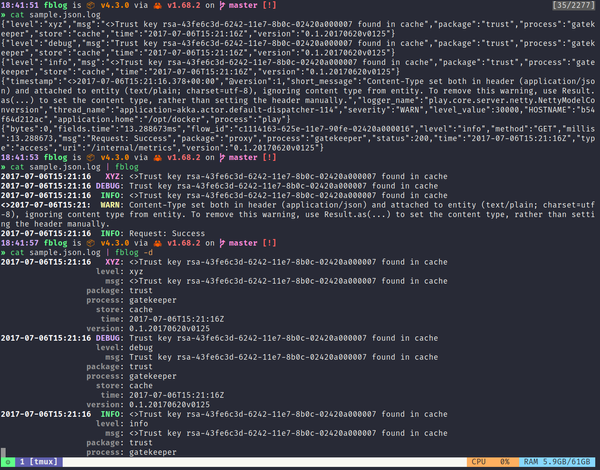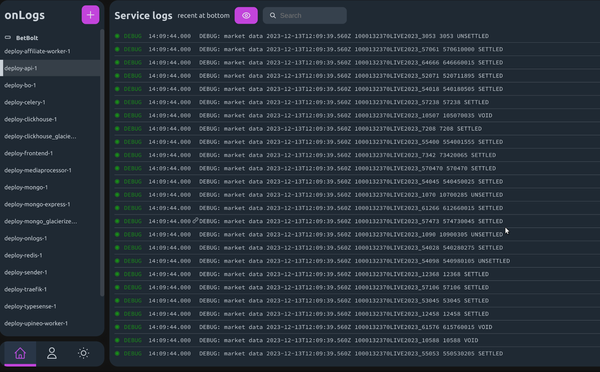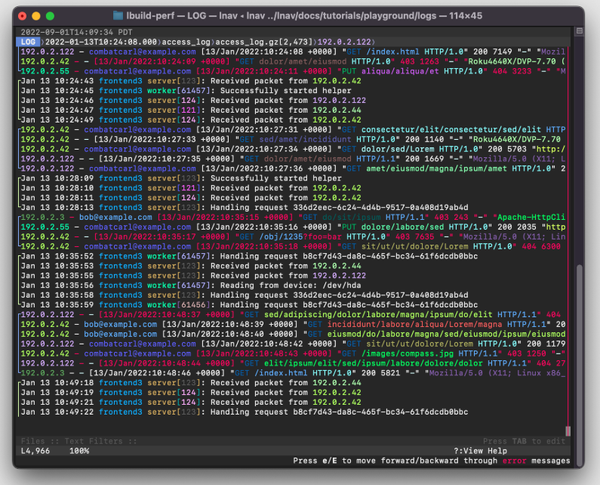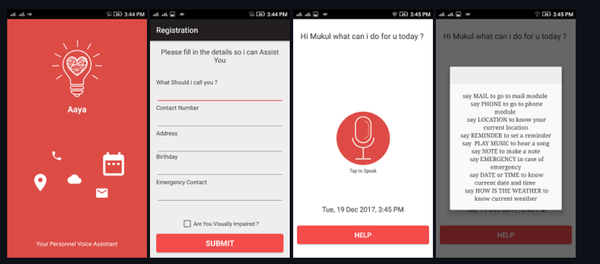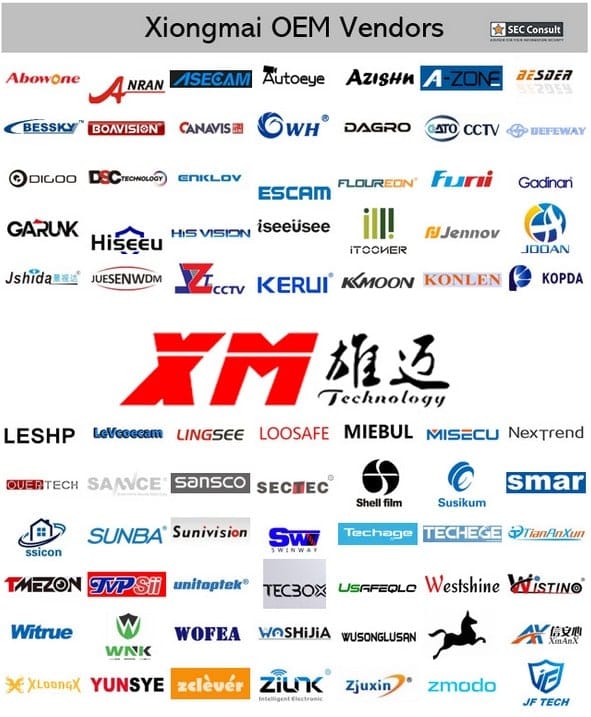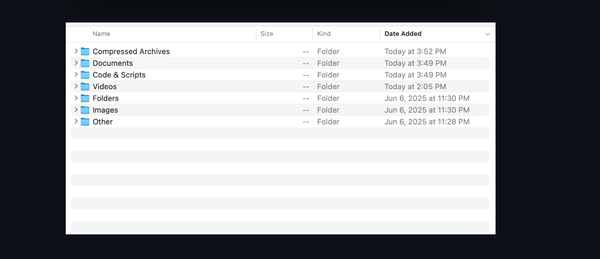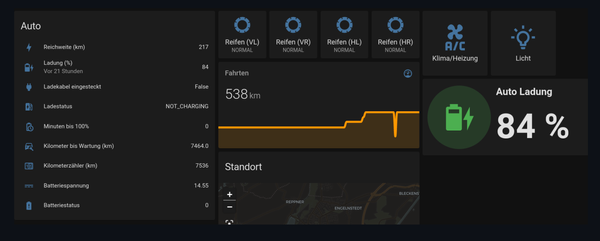Own Your Email: 17 Open-Source Mail Servers to Ditch Gmail & Take Back Control
Table of Content
What Exactly is an SMTP Server?
An SMTP (Simple Mail Transfer Protocol) server is essentially the postal service of the digital world. Just like how you drop a letter in a mailbox to be delivered to someone's address, an SMTP email server handles the delivery of your emails from your device to the recipient's inbox.
When you send an email, the SMTP server acts as the intermediary that routes your message through the internet to reach its destination. It's the behind-the-scenes technology that makes email communication possible.
What is an Email SMTP Server? A Complete Guide for Agencies
Self-Hosted vs. Third-Party SMTP Servers
Traditional Email Providers
Most people use SMTP servers provided by companies like:
- Gmail (smtp.gmail.com)
- Outlook/Hotmail (smtp-mail.outlook.com)
- Yahoo (smtp.mail.yahoo.com)
These work great for personal use, but agencies and businesses often need more robust solutions, even though they can make a pro/ enterprise account for their employees.
Self-Hosted SMTP Servers
Self-hosted SMTP means running your own email server infrastructure rather than relying on external providers. This gives you complete control over your email system.
Why Agencies Choose Self-Hosted SMTP Servers
1. Enhanced Deliverability Control
Agencies sending high volumes of emails need to maintain good sender reputations. With self-hosted SMTP server, you have direct control over:
- IP reputation management
- Sending limits and throttling
- Authentication protocols (SPF, DKIM, DMARC)
- Bounce handling and feedback loops
2. Professional Branding
Using your own domain for email delivery (rather than @gmail.com) creates credibility with clients and recipients. It looks more professional and trustworthy.
3. Cost-Effective for High Volumes
While there's an initial setup cost, self-hosted solutions become more economical when sending thousands of emails monthly compared to per-email pricing from third-party services.
4. No Third-Party Limitations
Avoid restrictions on:
- Daily sending limits
- List size restrictions
- Content filtering that might block legitimate marketing emails
- Account suspensions due to spam complaints
Privacy Benefits of Self-Hosted SMTP
Complete Data Control
When you self-host your SMTP email server, your email data never touches third-party servers. This means:
- No data mining: Email providers can't scan your messages for advertising purposes
- Enhanced security: Sensitive client communications stay within your infrastructure
- Compliance: Easier adherence to GDPR, HIPAA, and other privacy regulations
- Audit trails: Full visibility into email logs and delivery reports
Reduced Security Risks
Third-party email services can be targets for hackers. By hosting your own SMTP server, you eliminate one potential attack vector and maintain control over your security protocols.
Technical Considerations
Setup Requirements
Running your own SMTP server requires:
- Dedicated server or VPS hosting
- Static IP address
- Domain name with proper DNS records
- SSL certificates
- Ongoing maintenance and monitoring
- Spam filtering and security measures
Popular Self-Hosted SMTP Solutions
- Postfix: Open-source, highly configurable
- Exim: Flexible and powerful
- hMailServer: User-friendly for Windows environments
- Mail-in-a-Box: Simplified setup for small agencies
Why Setting Up a Mail Server Is Hard (And How Open-Source Docker Solutions Are Making It Easier)
Let’s be honest: setting up your own mail server is not for the faint of heart.
You might think, “How hard can it be? It’s just sending and receiving emails.” But if you’ve ever tried to run your own email infrastructure, you already know, it’s a rabbit hole of DNS records, security protocols, spam filters, and constant maintenance.
I’ve been there. I’ve spent hours debugging SMTP errors, fighting with reverse DNS, and watching my emails land straight in recipients’ spam folders. And I’m not alone.
So why is it so hard to set up a mail server? Let’s break it down, like a human, not a network engineer.
1. Email Isn’t Just “Send and Forget”
Unlike a website or a file server, email is a real-time, trust-based communication system. Your server doesn’t just talk to one place, it talks to everyone. And the internet is full of spam.
That means every other mail server on the planet is suspicious of you by default. If you don’t configure things perfectly, your messages get rejected or marked as spam, even if you’re 100% legit.
2. The Setup Is a Maze of Protocols
To even begin working, you need to configure a dozen different technologies correctly:
- SMTP (for sending mail)
- IMAP/POP3 (for receiving mail)
- SSL/TLS (for encryption)
- DKIM (to sign your emails so they’re not forged)
- SPF (to say who’s allowed to send from your domain)
- DMARC (to tell others what to do with fake emails claiming to be you)
- Reverse DNS (so other servers can verify your IP)
Miss one? Your emails fail. Misconfigure one? You’re in spam jail.
And getting all these to work together? That’s where the real headache begins.
3. Deliverability Is the Real Challenge
Even if your server works locally, getting your emails to actually arrive in someone’s inbox is the real battle.
Big providers like Gmail, Outlook, and Yahoo use aggressive spam filters. They look at:
- Your server’s reputation
- Whether your IP has been used for spam before
- How many emails you’re sending
- Whether your domain has a history of abuse
If you’re on a residential IP or a cheap VPS, you’re already starting at a disadvantage.
And if one user marks your email as spam? That can tank your reputation fast.
4. Maintenance Never Stops
A mail server isn’t “set it and forget it.” You have to:
- Monitor logs for errors
- Update software to patch security holes
- Rotate certificates
- Block spammers and bots
- Handle storage for mailboxes and backups
And if something breaks? You’re on your own. No customer support. No magic “reset” button.
When Self-Hosted SMTP Makes Sense
Ideal Scenarios:
- Agencies sending 10,000+ emails monthly
- Businesses requiring complete data privacy
- Companies in regulated industries (healthcare, finance)
- Organizations wanting full control over deliverability
- Those experiencing deliverability issues with third-party providers
Consider Third-Party Services When:
- Limited technical expertise
- Low email volume (under 1,000 emails/month)
- Budget constraints for infrastructure
- Need for advanced analytics and templates
- Quick setup requirements
Best Practices for Self-Hosted SMTP
1. Proper Configuration
- Set up SPF, DKIM, and DMARC records
- Configure proper reverse DNS (PTR records)
- Implement proper throttling to avoid overwhelming recipients
2. Security Measures
- Regular security updates
- Strong authentication protocols
- Monitoring for unusual activity
- Backup and disaster recovery plans
3. Deliverability Maintenance
- Monitor sender reputation scores
- Handle bounces and complaints promptly
- Maintain clean email lists
- Warm up new IP addresses gradually
1- Docker Mailserver
This is a production-ready fullstack but simple mail server (SMTP, IMAP, LDAP, Antispam, Antivirus, etc.) running inside a container.
It does not require database as all configuration files are backed in text files.
It includes the following services:
- Postfix with SMTP or LDAP authentication and support for extension delimiters
- Dovecot with SASL, IMAP, POP3, LDAP, basic Sieve support and quotas
- Rspamd
- Amavis
- SpamAssassin supporting custom rules
- ClamAV with automatic updates
- OpenDKIM & OpenDMARC
- Fail2ban
- Fetchmail
- Getmail6
- Postscreen
- Postgrey
- Support for LetsEncrypt, manual and self-signed certificates
- A setup script for easy configuration and maintenance
- SASLauthd with LDAP authentication
- OAuth2 authentication (via
XOAUTH2orOAUTHBEARERSASL mechanisms)
2- Mail-in-a-Box
Mail-in-a-Box helps individuals take back control of their email by defining a one-click, easy-to-deploy SMTP+everything else server: a mail server in a box.
Mail-in-a-Box turns a fresh Ubuntu 22.04 LTS 64-bit machine into a working mail server by installing and configuring various components.
It is a one-click email appliance. There are no user-configurable setup options. It "just works."
The components installed are:
- SMTP (postfix), IMAP (Dovecot), CardDAV/CalDAV (Nextcloud), and Exchange ActiveSync (z-push) servers
- Webmail (Roundcube), mail filter rules (thanks to Roundcube and Dovecot), and email client autoconfig settings (served by nginx)
- Spam filtering (spamassassin) and greylisting (postgrey)
- DNS (nsd4) with SPF, DKIM (OpenDKIM), DMARC, DNSSEC, DANE TLSA, MTA-STS, and SSHFP policy records automatically set
- TLS certificates are automatically provisioned using Let's Encrypt for protecting https and all of the other services on the box
- Backups (duplicity), firewall (ufw), intrusion protection (fail2ban), and basic system monitoring (munin)
It also supports static website hosting since the box is serving HTTPS anyway. (To serve a website for your domains elsewhere, just add a custom DNS "A" record in you Mail-in-a-Box's control panel to point domains to another server.)
3- mailcow: Your Email Server (Dockerized)
Similar as previous projects, The mailcow project packed many open-source emailing services in one easy Docker setup. It also include SMTP support as various other protocols.
4- Mox
Mox is a modern full-featured open source secure mail server for low-maintenance self-hosted email. It is released under the popular open-source MIT license.
Mox has been tested with several email clients as Mozilla Thunderbird, iOS Email, Microsoft Outlook, and several others.
Mox's Features
- Quick and easy to start/maintain mail server, for your own domain(s).
- SMTP (with extensions) for receiving, submitting and delivering email.
- IMAP4 (with extensions) for giving email clients access to email.
- Webmail for reading/sending email from the browser.
- SPF/DKIM/DMARC for authenticating messages/delivery, also DMARC aggregate reports.
- Reputation tracking, learning (per user) host-, domain- and sender address-based reputation from (Non-)Junk email classification.
- Bayesian spam filtering that learns (per user) from (Non-)Junk email.
- Slowing down senders with no/low reputation or questionable email content (similar to greylisting). Rejected emails are stored in a mailbox called Rejects for a short period, helping with misclassified legitimate synchronous signup/login/transactional emails.
- Internationalized email (EIA), with unicode in email address usernames ("localparts"), and in domain names (IDNA).
- Automatic TLS with ACME, for use with Let's Encrypt and other CA's.
- DANE and MTA-STS for inbound and outbound delivery over SMTP with STARTTLS, including REQUIRETLS and with incoming/outgoing TLSRPT reporting.
- Web admin interface that helps you set up your domains, accounts and list aliases (instructions to create DNS records, configure SPF/DKIM/DMARC/TLSRPT/MTA-STS), for status information, and modifying the configuration file.
- Account autodiscovery (with SRV records, Microsoft-style, Thunderbird-style, and Apple device management profiles) for easy account setup (though client support is limited).
- Webserver with serving static files and forwarding requests (reverse proxy), so port 443 can also be used to serve websites.
- Simple HTTP/JSON API for sending transaction email and receiving delivery events and incoming messages (webapi and webhooks).
- Prometheus metrics and structured logging for operational insight.
- "mox localserve" subcommand for running mox locally for email-related testing/developing, including pedantic mode.
- Most non-server Go packages mox consists of are written to be reusable.
5- Nortix Mail - disposable email server with an easy setup
While Nortix Mail supports SMPT by default, it is built as a disposable email server.

6- Stalwart
Stalwart is an open-source mail & collaboration server with JMAP, IMAP4, POP3, SMTP, CalDAV, CardDAV and WebDAV support and a wide range of modern features. It is written in Rust and designed to be secure, fast, robust and scalable.
You can check about its features here.

7- BillionMail
BillionMail is a future open-source email server and marketing platform designed to give businesses and individuals complete control over their email campaigns.
It will support newsletters, promotional emails, and transactional messages, offering features like advanced analytics and customer management.
With BillionMail, users can create, send, and track emails efficiently, empowering them to run professional-grade email marketing campaigns with full transparency and no reliance on third-party services.
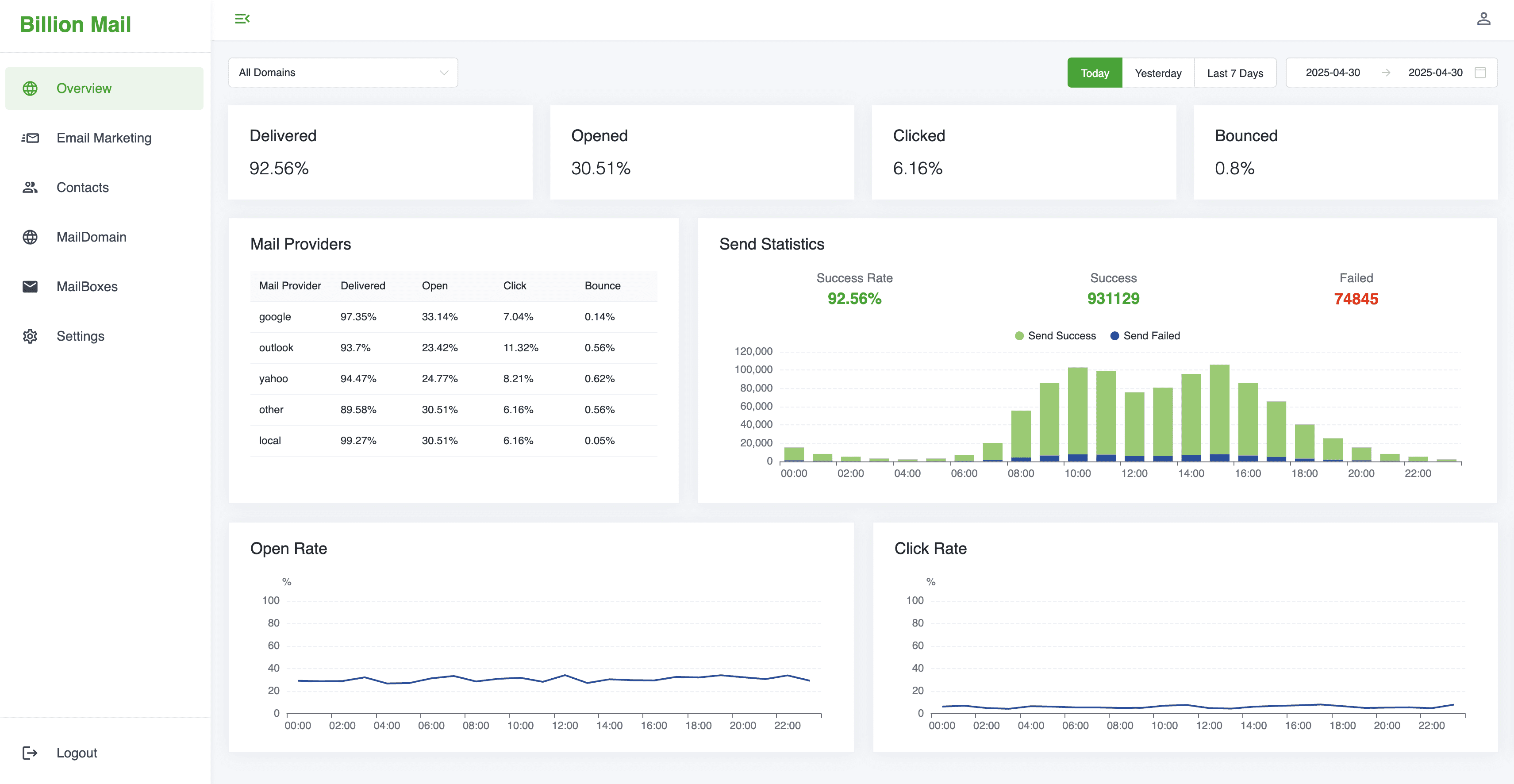
8- Mailu

Mailu is a simple yet full-featured mail server as a set of Docker images. It is free software (both as in free beer and as in free speech), open to suggestions and external contributions.
The project aims at providing people with an easily setup, easily maintained and full-featured mail server while not shipping proprietary software nor unrelated features often found in popular groupware.
Mailu's Features
- Standard email server, IMAP and IMAP+, SMTP and Submission with auto-configuration profiles for clients
- Advanced email features, aliases, domain aliases, custom routing, full-text search of email attachments
- Web access, multiple Webmails and administration interface
- User features, aliases, auto-reply, auto-forward, fetched accounts, managesieve
- Admin features, global admins, announcements, per-domain delegation, quotas
- Security, enforced TLS, DANE, MTA-STS, Letsencrypt!, outgoing DKIM, anti-virus scanner, Snuffleupagus, block malicious attachments
- Antispam, auto-learn, greylisting, DMARC and SPF, anti-spoofing
- Freedom, all FOSS components, no tracker included
9- Twisted
While Twisted is not a mail server, it is a Python event-based framework for building web apps, it supports many email protocols such as SMTP, IMAP, and POP3.
Developers can use it to build their own SMTP mail servers or include it as a functionality in their apps.
10- Haraka - a Node.js Mail Server
Haraka is a blazing-fast, open-source email server built with Node.js. Designed for scale, it handles thousands of connections and messages per second.
With a powerful plugin architecture, it’s perfect as a smart, customizable MTA for filtering, relaying, and securing email, not storing it.
Think of Haraka as the brain behind your email flow: lightweight, modular, and built for performance. It integrates seamlessly with systems like Postfix, Exim, or Exchange for storage, while handling inbound filtering, outbound delivery, and spam protection with ease.
Developers can write plugins in JavaScript, automate workflows, and build a mail server that works exactly how you want.
11- MailSlurper
MailSlurper is a lightweight, easy-to-use SMTP mail server designed for developers and small teams who need to test email functionality in their applications.
Instead of sending real emails, MailSlurper "slurps" them into a local database, letting you safely capture and review messages without the risk or complexity of setting up a full email server.
Read more about it here.
12- Sendria (SMTP Test Server)
Sendria (formerly MailTrap) is a SMTP server designed to run in your dev/test environment, catch any email you or your application is sending, and display it in a web interface instead of sending to real world.
It help you prevent sending any dev/test emails to real people, no matter what address you provide. Just point your app/email client to smtp://127.0.0.1:1025 and look at your emails on http://127.0.0.1:1080.
Sendria is built on shoulders of:
- MailCatcher - original idea comes of this tool by Samuel Cochran.
- MailDump - base source code of
Sendria(version pre 1.0.0), by Adrian Mönnich.
Sendria included features:
- Catch all emails and store it for display.
- Full support for multipart messages.
- View HTML and plain text parts of messages (if given part exists).
- View source of email.
- Lists attachments and allows separate downloading of parts.
- Download original email to view in your native mail client(s).
- Mail appears instantly if your browser supports WebSockets.
- Optionally, send webhook on every received message.
- Runs as a daemon in the background, optionally in foreground.
- Keyboard navigation between messages.
- Optionally password protected access to web interface.
- Optionally password protected access to SMTP (SMTP AUTH).
- It's all Python!
13- Papercut SMTP
Papercut SMTP is a 2-in-1 quick email viewer AND built-in SMTP server (designed to receive messages only). Papercut SMTP doesn't enforce any restrictions on how you prepare your email, but it allows you to view the whole email-chilada: body, HTML, headers, and attachment right down to the naughty raw encoded bits.
Papercut can be configured to run on startup and sit quietly (minimized in the tray) only providing a notification when a new message has arrived.
14- Erooster
Erooster is a free and open-source SMTP mail server suite written in Rust meant to be easy to use.
15- Postal
Postal is a complete and fully featured mail server for use by websites & web servers. Think Sendgrid, Mailgun or Postmark but open source and ready for you to run on your own servers.
16- hMailServer

17- Frappe Mail Server

18- iRedMail
Making the Decision
Choosing between self-hosted and third-party SMTP depends on your specific needs. For agencies handling large volumes of client emails or requiring maximum privacy, self-hosted solutions offer significant advantages. However, they require technical expertise and ongoing maintenance.
Consider starting with a hybrid approach - using third-party services for transactional emails while self-hosting for marketing campaigns, or gradually migrating as your technical capabilities grow.
The investment in self-hosted SMTP often pays off through improved deliverability, enhanced privacy, and long-term cost savings for growing agencies.
Looking for a reliable test email server?
We've got you covered. Check out our curated list of open-source, Docker-friendly mail servers like Mailcow, Mailu, and Haraka, perfect for testing, staging, and development.
Whether you're a developer, sysadmin, or just tinkering with email automation, these tools will help you set up a lightweight, secure environment in minutes.
Don’t just guess what works, see it in action. Explore the list now and find the perfect fit for your next project.
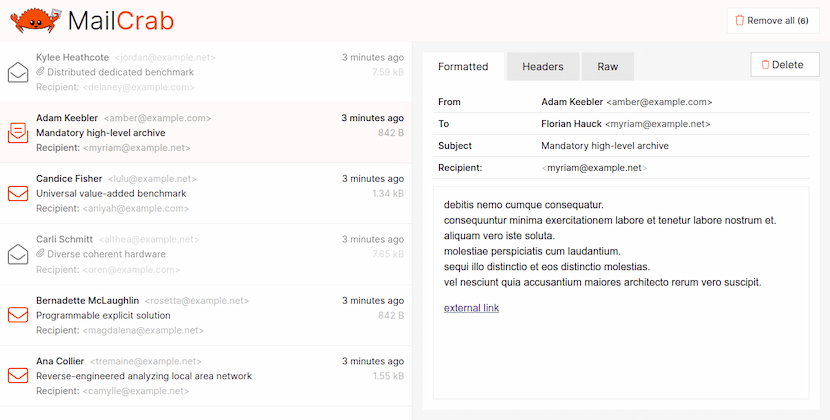
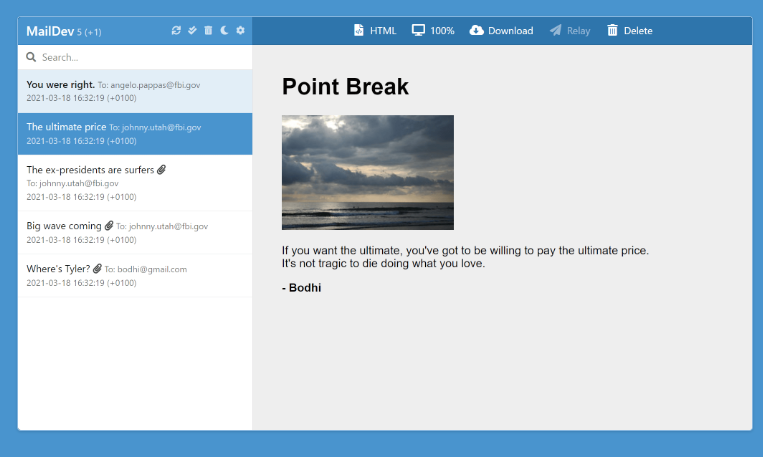
Final Note
In this article, we’ve curated and reviewed 17 powerful open-source mail servers, each serving a unique purpose, from development and testing to enterprise-grade email delivery and marketing.
Here’s the breakdown:
- For Developers & Testing: 4 (MailSlurper, MailDev, Inbucket, Sendria) - You can also check our email test suites list here.
- For Self-Hosting & Full Email Suites: 9 (Docker Mailserver, Mail-in-a-Box, mailcow, Mailu, iRedMail, Stalwart, erooster, mjl/mox, Frappe Mail Server)
- For High-Volume & Marketing Use: 3 (Haraka, Postal, BillionMail)
- For Windows Users: 1 (hMailServer)
All are free, open-source, and community-driven — with many built on Docker for easy setup.
Do Your Need Help to Setup your Own Mail Server?
Setting up your own mail server can feel overwhelming, from DNS records to DKIM, SPF, and DMARC, the details matter. But you don’t have to go it alone.
If you need help setting up, configuring, or securing your self-hosted email server, we’re here for you.
Whether you're a developer testing locally or an agency deploying a production-grade solution, we can guide you through the process, help you choose the right tool, and ensure your emails land in inboxes, not spam folders.














